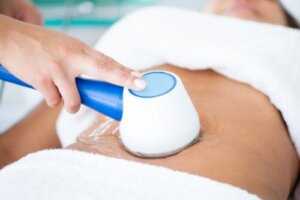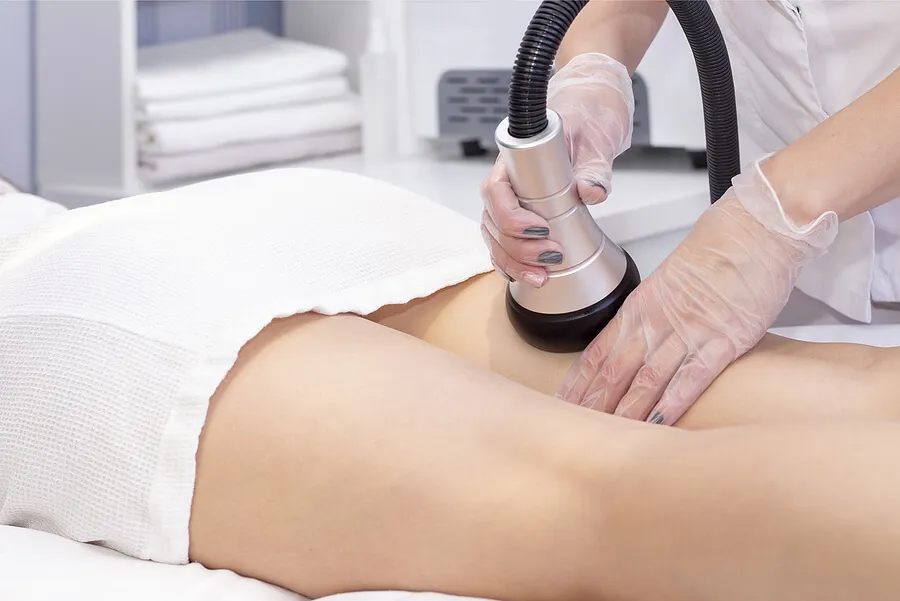Hydrolipoclasia: What Is it and What Are its Risks?

Hydrolipoclasia is an alternative to traditional liposuction in terms of fighting cellulite, treating localized fat, and reducing fat volume. It’s relatively minimally invasive and the results achieved are equivalent to those of surgical liposculpture, although faster and at a lower cost.
In this aesthetic procedure, a sterile physiological solution is applied in the areas where localized adiposities (fat deposits) are to be eliminated. Then, cavitation is used to break up the fat cells that are eliminated with suction or naturally by the lymphatic system.
Hydrolipoclasia can help reduce adipose tissue or fat in different areas of the body, such as the abdomen, buttocks, thighs, arms, and jaw. However, it’s not recommended for obese people, nor is it considered a weight-loss treatment.
What is Hydrolipoclasia?
More and more people are concerned about their physical appearance. Meanwhile, specialists are also always looking for new and more effective procedures to help you improve your appearance.
Now, one of the problems that generate more headaches in terms of aesthetics is trying to lose localized fat. Adipose tissue accumulates in certain areas of the body and is very difficult to eliminate.
For this reason, various aesthetic treatments can be used. Among these is hydrolipoclasia. This technique is named because water is used to break or explode the fat cells. Etymologically, the name comes from hydro (water), lipo (fat), and clasis (to break).
In addition to water injected in sterile solutions, this treatment uses a device that generates high-frequency vibratory waves (or ultrasound). It’s positioned to break the fat cells. In short, hydrolipoclasia is a treatment to eliminate localized fat.
This treatment is indicated for the treatment of localized adiposity in the abdominal area (including the sides), thighs, buttocks, arms, back, and even double chins. However, the doctor will determine where to treat, depending on the body and the type of fatty tissue.

We think you’ll like this article: Healthy Snacks for Any Time of the Day
What is the procedure like?
There are non-invasive and invasive aesthetic treatments. Hydrolipoclasy is at an intermediate treatment, since it’s not a surgery per se, but it still requires anesthesia.
First of all, a doctor makes a diagnosis by evaluating the fat deposits and determining which is the priority area to work on. Then, the areas to be treated are marked and disinfected.
It should be noted that hydrolipoclasia requires local anesthesia. Lidocaine is commonly injected. This means that the person is conscious during the procedure. However, this does not mean that he/she can observe what the doctors are doing.
Once the patient is under the effects of anesthesia, the adipose tissue is infiltrated with a hypotonic or low osmolarity solution, which may contain bicarbonate and salt. This causes water to enter the adipocytes, producing distension or swelling and weakening the cell membrane.
However, the other part of this treatment involves the use of low-frequency focused ultrasound in the area to be treated. This way, the temperature increases, and a cavitation process takes place. Bubbles are generated, causing the rupture or bursting of the fat cells.
To complete the treatment, a microcannula is introduced, whose function is to suction the fat. In addition, the body itself also eliminates the broken adipocytes by natural metabolic pathways, so the process is complemented with massages to help lymphatic drainage.
Finally, the healing is done and a girdle is placed. Thus, the use of a post-liposuction girdle is recommended. This enhances the results and helps to shape the figure.
The person will have to spend a short time in recovery. The total duration of the treatment varies from one to two and a half hours, at most. Also, several sessions may be required.
Read: Nutrients and Exercises to Maintain a Healthy, Clean, and Strong Liver
The benefits of hydrolipoclasia
According to a clinical study conducted with 64 patients, hydrolipoclasia does indeed help decrease waist circumference by up to 8% and body fat by 6.4%. This can come with an increase in muscle mass of up to 1.3%.
In this sense, it’s considered an effective and novel technique for the treatment of local fat, through the joint action of water and ultrasound. In this regard, various benefits and advantages also come with it:
- This treatment reduces cellulite, as well as the appearance of “orange peel skin.”
- It removes as much fat as liposuction, but without going through the operating room.
- This treatment is more budget-friendly.
- It’s minimally invasive.
- This treatment does not require hospitalization or recovery.
- It can reduce between 1 to 2 centimeters of fat per session.
- Finally, it doesn’t leave visible scars.
Care before and after the procedure
To guarantee the effectiveness of this treatment, it’s important to minimize your consumption of fat and alcohol, to help the body metabolize the fat shed in the procedure.
Additionally, after the treatment it is suggested to take into account the following recommendations:
- No physical exertion during the following days
- Attend drainage or lymphatic massage sessions for at least 3 weeks
- Maintain adequate hydration
- Use girdles to shape your figure for the time indicated by the treating physician
- Apply creams with vitamin K in the area to reduce bruising
After this procedure, the total recovery time may vary, sometimes up to three weeks or even six weeks.
The risks, side effects, and contraindications of hydrolipoclasia
One of the first precautions that should be taken into account is the fact that some people may present allergic reactions to anesthesia. In particular, according to research, lidocaine should be used with caution in patients with heart failure as well as kidney or liver disease and myasthenia gravis.
On the other hand, some discomfort may occur after hydrolipoclasis. However, this usually resolves with time. It all depends on the sensitivity of the patient. Among the possible side effects is the appearance of bruising, redness and darkening of the skin, pain or sensation of needles, and the formation of a seroma.
On the other hand, the hidrolipoclasia is contraindicated in several cases:
- Pregnant or breastfeeding women
- Children under 18 years of age
- Patients with hyperthyroidism or high blood pressure, obesity, skin infections, or tumors
- Treatment with anticoagulants

The importance of adopting healthy habits after hydrolipoclasy
Hydrolipoclasy can be an effective technique for the treatment of localized fat in both women and men. Plus, it even helps in the management of cellulite.
It’s also minimally invasive and safe. So far, there have been no reported cases of deaths related to the procedure. However, it is always necessary to take the necessary precautions and perform it only with plastic surgeons.
Notwithstanding the effectiveness of the procedure, it’s necessary to change to a healthy and balanced diet and eliminate alcohol consumption. Plus, you must participate in regular physical activity to prevent the formation of localized fat again.
All cited sources were thoroughly reviewed by our team to ensure their quality, reliability, currency, and validity. The bibliography of this article was considered reliable and of academic or scientific accuracy.
- Godoy F, et al. Structural changes of fat tissue after nonaspirative ultrasonic hydrolipoclasy J Cutan Aesthet Surg. 2011; 4(2):105-10.
- Insua E, Fernandez J. Tratamiento de adiposidades localizadas mediante técnicas no quirúrgicas. Nutrición Clínica y Dietética Hospitalaria. 2012; 32(2): 37-43.
- Motta A. Hidrolipoclasia abdominal: variaciones técnicas y resultados antropométricos, en tres centros de medicina estética de Bogotá. Colombia: Universidad del Rosario, 2011. Trabajo de grado.
- Reyes M. Características biológicas del tejido adiposo: el adipocito como célula endocrina, Revista Médica Clínica Las Condes. 2012: 23(2): 136-144.
- Smerilli A, Sacot N. Anestésicos locales: historia, acción farmacológica, mecanismo de acción, estructura química y reacciones adversas. Revista de la Facultad de Odontología UBA. 2004; 46: 19-24.
- Song A, Bennett J, Marra K, et al. Scientific basis for the use of hypotonic solutions with ultrasonic liposuction. Aesthetic Plast Surg. 2006; 30(2): 233-238.
This text is provided for informational purposes only and does not replace consultation with a professional. If in doubt, consult your specialist.








